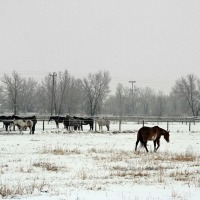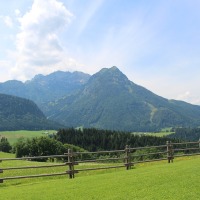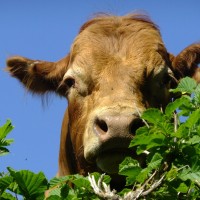

Cattle Management -5 Tips for Winter
 Weather is always a big factor while raising animals on your farm. Currently, the dropping temperature and cold related stress could make your animals vulnerable to diseases. Dropping temperature, wet ground, along with the wind chill make it challenging for cattle farmers to raise a healthy herd.On top of that, you might have frozen water and pastures making food and water scarce for the...
Weather is always a big factor while raising animals on your farm. Currently, the dropping temperature and cold related stress could make your animals vulnerable to diseases. Dropping temperature, wet ground, along with the wind chill make it challenging for cattle farmers to raise a healthy herd.On top of that, you might have frozen water and pastures making food and water scarce for the...

Improve Cattle Handling with “Follow the Leader” Instincts
 Posted by SLN Staff on Nov 5th, 2014 | Comments Off on Improve Cattle Handling with “Follow the Leader” Instincts
Posted by SLN Staff on Nov 5th, 2014 | Comments Off on Improve Cattle Handling with “Follow the Leader” Instincts 
 We continue with our cattle handling tips, giving you valuable information on animal behavior. In our previous blogs, we have discussed the importance of stress free cattle handling and understanding cattle behavior for leading cattle in pasture &rotational grazing safely. This article will specifically focus on handing cattle, sheep, pigs and other herding animals using their “follow the...
We continue with our cattle handling tips, giving you valuable information on animal behavior. In our previous blogs, we have discussed the importance of stress free cattle handling and understanding cattle behavior for leading cattle in pasture &rotational grazing safely. This article will specifically focus on handing cattle, sheep, pigs and other herding animals using their “follow the...

Leading Cattle in Pasture & Rotational Grazing
 Learning animal behavior can make it a lot easier for ranchers and animal handlers to guide cattle in the desired pasture areas in a stress-free way. Grazing your cattle in rotations on different pastures will allow your pasture grass to grow and recover. We know from our previous blogs that you have to get familiar with your animals before they can fully trust you, and let you into their...
Learning animal behavior can make it a lot easier for ranchers and animal handlers to guide cattle in the desired pasture areas in a stress-free way. Grazing your cattle in rotations on different pastures will allow your pasture grass to grow and recover. We know from our previous blogs that you have to get familiar with your animals before they can fully trust you, and let you into their...

Recommended Livestock Safety & Handling Tips
 Posted by SLN Staff on Oct 15th, 2014 | Comments Off on Recommended Livestock Safety & Handling Tips
Posted by SLN Staff on Oct 15th, 2014 | Comments Off on Recommended Livestock Safety & Handling Tips 
 Handling livestock safely and keeping them free from stress tends to increase the productivity of any farm. Feeling stress reduces both rumen and immune functions of animals, and also lowers conception rates. Handlers who are experienced and understand animal behavior can reduce stress and increase the productivity of farm animals. The purpose of this article is to inform handlers about...
Handling livestock safely and keeping them free from stress tends to increase the productivity of any farm. Feeling stress reduces both rumen and immune functions of animals, and also lowers conception rates. Handlers who are experienced and understand animal behavior can reduce stress and increase the productivity of farm animals. The purpose of this article is to inform handlers about...

Top 5 Reasons to Eat Grass-Fed Meat
 Do we eat grasses? The truth is, we do. We do eat a bit of grass when we eat corn, rice and wheat, all of which are grasses. But actually, what we eat is their seeds, the dense package of complex carbohydrates that is the specialty of annual grasses. Perennial grasses, which are more common, pack a larger proportion of their energy in their roots, stems and leaves; the building block for these...
Do we eat grasses? The truth is, we do. We do eat a bit of grass when we eat corn, rice and wheat, all of which are grasses. But actually, what we eat is their seeds, the dense package of complex carbohydrates that is the specialty of annual grasses. Perennial grasses, which are more common, pack a larger proportion of their energy in their roots, stems and leaves; the building block for these...



Powered by WordPress | Designed by Elegant Themes



